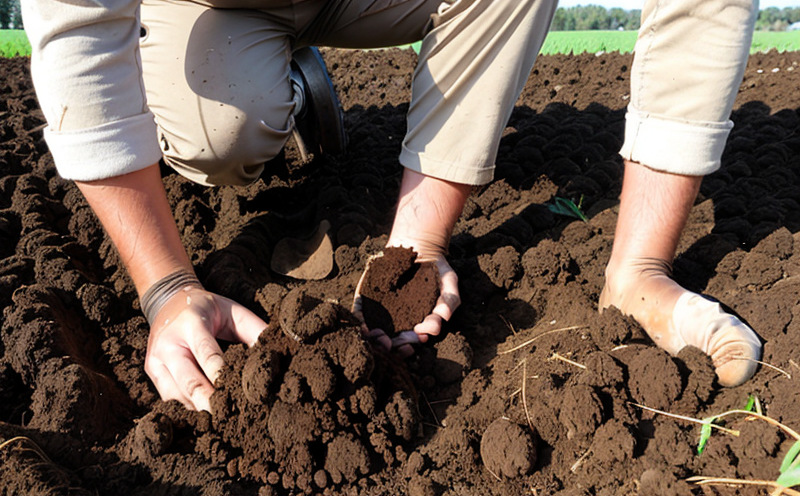Soil Quality & Fertility Testing
In agriculture and forestry testing, soil quality and fertility play a pivotal role in determining the overall productivity and sustainability of agricultural practices. Soil is the foundation upon which plant growth occurs, and its health directly impacts crop yields, water retention, and environmental conservation.
Soil quality encompasses various parameters including physical properties (texture, structure), chemical composition (nutrient content, pH levels), biological activity (microbial diversity), and ecological functions. Fertility testing focuses on assessing the availability of essential nutrients to plants, such as nitrogen, phosphorus, potassium, calcium, magnesium, sulfur, iron, zinc, copper, manganese, and boron.
Understanding these parameters is crucial for sustainable agricultural practices. For instance, excessive or insufficient levels of certain nutrients can lead to suboptimal crop growth, increased pest pressures, or even soil degradation. By conducting thorough testing, farmers and researchers can optimize nutrient management strategies, enhancing both yield and sustainability.
The process typically involves collecting representative soil samples from various parts of the field. These samples are then analyzed using advanced laboratory techniques to determine their physical and chemical properties. The results provide insights into the current state of the soil and guide decision-making processes for fertilization and land management.
| Standard | Description |
|---|---|
| ISO 14688-2:2019 | Determination of nitrogen, phosphorus and potassium in soil by extraction with a mixture of nitric acid and perchloric acid. |
| ASTM D2733-14e1 | Test methods for determination of available soil nutrients by extraction with ammonium-acetate buffer solution. |
| EN ISO 15086-1:2019 | Determination of organic carbon in soils and plant residues - Part 1: Potometric titration. |
| IEC 62374-1:2015 | Electrode sensors for measuring soil properties - Determination of electrical conductivity, pH and temperature in soils. |
The choice of standard depends on the specific needs of the project. For instance, ISO 14688-2 is often used for nutrient content analysis, while ASTM D2733 helps in assessing available soil nutrients. Understanding these standards ensures that testing methods are consistent and reliable, facilitating accurate comparisons across different regions or studies.
Testing also involves evaluating the physical attributes of the soil such as texture, structure, and porosity. These factors influence water infiltration rates, aeration, and root growth. Advanced techniques like X-ray fluorescence (XRF) spectrometry can provide detailed elemental analyses, while near-infrared spectroscopy (NIRS) offers rapid assessments of organic matter content.
Biological indicators such as microbial biomass carbon or nitrogen are also crucial for assessing soil health. These measures reflect the vitality and diversity within the soil ecosystem, which is vital for maintaining long-term productivity without compromising environmental integrity.
Why It Matters
The importance of soil quality and fertility testing cannot be overstated in agriculture and forestry. Healthy soils not only support robust plant growth but also contribute significantly to food security, climate resilience, and biodiversity conservation.
By accurately assessing soil properties, farmers can make informed decisions about fertilization practices, irrigation management, and land use. This reduces the risk of over-fertilization or nutrient deficiencies, which can lead to environmental pollution and reduced crop yields.
Fertility testing also plays a critical role in sustainable agricultural practices. By identifying specific nutrient imbalances, it helps in implementing precision agriculture techniques that optimize resource use efficiency. This approach minimizes waste while maximizing productivity, aligning with global goals for sustainable development.
Moreover, soil health is intricately linked to ecosystem services such as carbon sequestration and water regulation. Degraded soils contribute to increased greenhouse gas emissions and reduced water quality, both of which have far-reaching impacts on human well-being and environmental stability.
Frequent monitoring through testing ensures that these critical functions are maintained or improved over time. This proactive approach supports long-term agricultural sustainability and contributes positively to global efforts towards climate change mitigation and adaptation.
Applied Standards
| Standard | Description |
|---|---|
| ISO 14688-2:2019 | Determination of nitrogen, phosphorus and potassium in soil by extraction with a mixture of nitric acid and perchloric acid. |
| ASTM D2733-14e1 | Test methods for determination of available soil nutrients by extraction with ammonium-acetate buffer solution. |
| EN ISO 15086-1:2019 | Determination of organic carbon in soils and plant residues - Part 1: Potometric titration. |
| IEC 62374-1:2015 | Electrode sensors for measuring soil properties - Determination of electrical conductivity, pH and temperature in soils. |
The application of internationally recognized standards ensures consistency and reliability in testing procedures. This is particularly important when comparing results across different regions or conducting inter-laboratory studies. Compliance with these standards also enhances the credibility and acceptance of test results, which are critical for regulatory compliance and scientific research.
International Acceptance and Recognition
- ISO 14688-2:2019 is widely accepted in Europe, North America, and parts of Asia for nutrient content analysis.
- ASTM D2733-14e1 is recognized globally for assessing available soil nutrients by extraction methods.
- EN ISO 15086-1:2019 is used extensively in Europe for determining organic carbon levels in soils and plant residues.
- IEC 62374-1:2015 has gained traction among agricultural research institutions worldwide due to its robustness in measuring soil properties.
The international acceptance of these standards underscores their importance in the global agricultural community. Laboratories adhering to these guidelines ensure that their results are widely understood and respected, fostering collaboration across borders.





